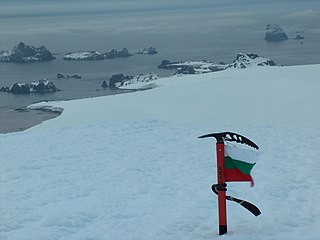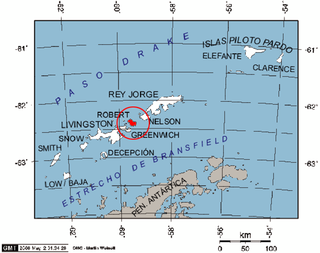
The South Shetland Islands are a group of Antarctic islands with a total area of 3,687 km2 (1,424 sq mi). They lie about 120 kilometres north of the Antarctic Peninsula, and between 430 and 900 km southwest of the nearest point of the South Orkney Islands. By the Antarctic Treaty of 1959, the islands' sovereignty is neither recognized nor disputed by the signatories and they are free for use by any signatory for non-military purposes.

Livingston Island is an Antarctic island in the Southern Ocean, part of the South Shetlands Archipelago, a group of Antarctic islands north of the Antarctic Peninsula. It was the first land discovered south of 60° south latitude in 1819, a historic event that marked the end of a centuries-long pursuit of the mythical Terra Australis Incognita and the beginning of the exploration and utilization of real Antarctica. The name Livingston, although of unknown derivation, has been well established in international usage since the early 1820s.

William Smith was an English captain born in Blyth, Northumberland, who discovered the South Shetland Islands, an archipelago off the Graham Land in Antarctica. His discovery was the first ever made south of 60° south latitude, in the present Antarctic Treaty area.

The Fildes Peninsula is a 7 km (4.3 mi) long peninsula that forms the south-western end of King George Island in the South Shetland Islands of Antarctica. It was named from association with nearby Fildes Strait by the UK Antarctic Place-Names Committee in 1960; the strait was likely named for Robert Fildes, a British sealer of the 1800s.

Robert Island or Mitchells Island or Polotsk Island or Roberts Island is an island 11 miles (18 km) long and 8 miles (13 km) wide, situated between Nelson Island and Greenwich Island in the South Shetland Islands, Antarctica. Robert Island is located at 62°24′S59°30′W. Surface area 132 km2 (51 sq mi). The name "Robert Island" dates back to around 1821 and is now established in international usage.

Rugged Island is an island 3 miles (4.8 km) long and 1 mile (1.6 km) wide, lying west of Livingston Island in the South Shetland Islands. Its surface area is 10.4 square kilometres (4.0 sq mi). The island's summit San Stefano Peak rises to 256 metres (840 ft) above sea level. Rugged Island is located at 62°38′S61°15′W. Rugged Island was known to both American and British sealers as early as 1820, and the name has been well established in international usage for over 100 years.

John Beach is a beach on the west side of the entrance to Walker Bay on the south coast of Livingston Island, in the South Shetland Islands. The ice-free area is around 109 hectares.

Wood Island is a conspicuous rocky island in Hero Bay, Livingston Island in the South Shetland Islands, Antarctica lying southeast of Desolation Island and Miladinovi Islets and forming the south side of Blythe Bay. Surface area 14 hectares .) The area was frequented by early nineteenth century English and American sealers operating from Blythe Bay.

Cora Cove is the 750 m wide cove in the northwest part of Blythe Bay indenting for 590 m the southeast coast of Desolation Island off Livingston Island in the South Shetland Islands, Antarctica. The cove was used by early 19th century sealers operating from Blythe Bay.

Bond Point is a small ice-free headland on the south coast of western Livingston Island in the South Shetland Islands, Antarctica forming the northeast side of the entrance to Kavarna Cove. Linzipar Lake is situated at the point's base. The area was visited by early 19th century sealers.

Half Moon Beach is a small crescent-shaped beach lying 1 nautical mile (2 km) south-east of Scarborough Castle on the north coast of Livingston Island, in the South Shetland Islands of Antarctica. The beach lieas at the western extremity of Porlier Bay in the north of Ioannes Paulus II Peninsula.

Spiller Cove is a small cove, part of Porlier Bay lying immediately west of Black Point along the north coast of Livingston Island, in the South Shetland Islands, which form a group of islands in the Antarctic Peninsula.
Providence was a merchant ship launched at Lynn in 1812. She sailed to Bengal and also made two voyages transporting convicts to Australia. She was wrecked in 1828 homeward bound from St Petersburg, Russia.
Robert entered Lloyd's Register in 1815 as an American prize. Until 1822 the brig was a West Indiaman based in Liverpool and sailing to the Bahamas or Havana. On 2 February 1817 Lloyd's List reported that Robert, Wilkes, master, had been sailing from New Providence to Liverpool when she struck a reef off Egg Island and had to put back for repairs.
Stirling was built in 1812 at Montreal, Quebec. She apparently traded out of Liverpool as a West Indiaman. There is little evidence that she traded as an East Indiaman. She was last listed in 1821 and a vessel named Sterling, sailing out of Quebec, was wrecked in November 1821.
Salisbury was launched c.1814 in the Brazils almost certainly under another name and was possibly a prize. She was possibly captured by the British or sold to British owners in 1815. She made one voyage seal hunting in 1820 and transported settlers to South Africa in 1821. She was lost in 1827.
Regalia was launched at Sunderland in 1811. In 1819 she made a voyage to Calcutta, sailing under a license from the British East India Company (EIC). She also sailed to New South Wales and Van Diemen's Land. From Sydney she engaged in several sealing hunting voyages to the waters around Macquarie Island. In 1826 she transported convicts from Dublin to New South Wales. From 1831 until 1852, when she was wrecked at Davis Strait, Regalia was a whaler in the northern whale fishery.
Indian was launched in Massachusetts in 1805, possibly under the same name. She first appeared in British records in 1814, suggesting that she was a prize. She was Liverpool-based and traded widely, especially with South America. She was in Valparaiso in 1820 when news of the discovery of the South Shetland Islands and the sealing grounds there reached Valparaiso before it reached England. She sailed to the South Shetland Islands and gathered over 25,000 seal skins before returning to Liverpool. Thereafter, she returned to trading across the Atlantic. Her crew abandoned her in a waterlogged state on 17 August 1827.
William was launched at Blyth in 1811. In 1818 a letter of marque captured her but she was then released. In October 1819 she fortuitously discovered the South Shetland Islands while on a voyage from Buenos Aires to Valparaiso. She was last listed in 1829.
Grand Sachem was launched at Newburyport, Massachusetts in 1801. She was registered at Bideford in 1803, but until 1815 sailed from Milford Haven. Between approximately 1803 and 1822, she made eight voyages as a whaler in the British southern whale fishery. She was last listed in 1822.










